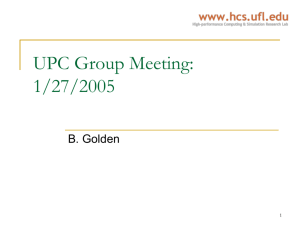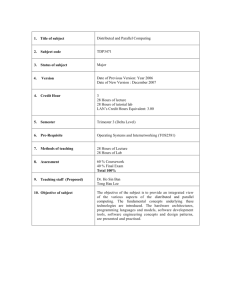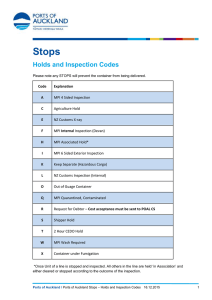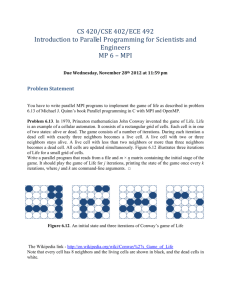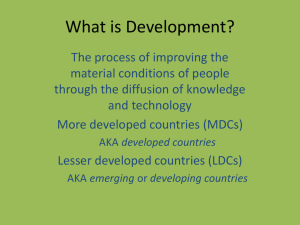Profile Guided MPI Protocol Selection for Point-to-Point Communication Calls
advertisement
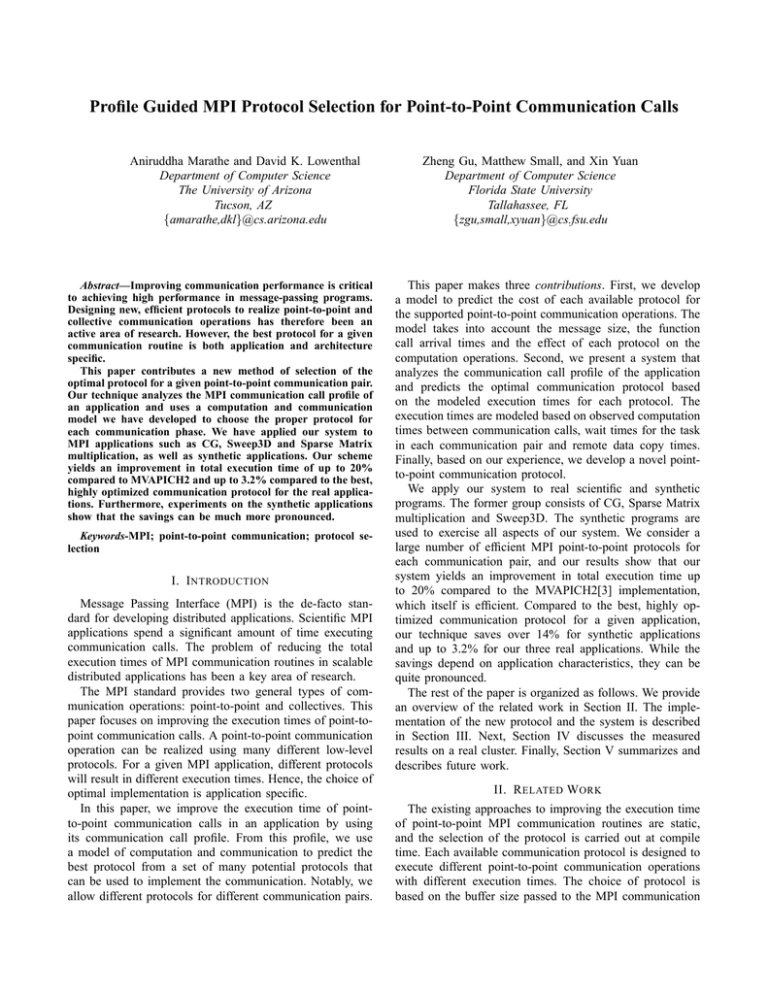
Profile Guided MPI Protocol Selection for Point-to-Point Communication Calls
Aniruddha Marathe and David K. Lowenthal
Department of Computer Science
The University of Arizona
Tucson, AZ
{amarathe,dkl}@cs.arizona.edu
Abstract—Improving communication performance is critical
to achieving high performance in message-passing programs.
Designing new, efficient protocols to realize point-to-point and
collective communication operations has therefore been an
active area of research. However, the best protocol for a given
communication routine is both application and architecture
specific.
This paper contributes a new method of selection of the
optimal protocol for a given point-to-point communication pair.
Our technique analyzes the MPI communication call profile of
an application and uses a computation and communication
model we have developed to choose the proper protocol for
each communication phase. We have applied our system to
MPI applications such as CG, Sweep3D and Sparse Matrix
multiplication, as well as synthetic applications. Our scheme
yields an improvement in total execution time of up to 20%
compared to MVAPICH2 and up to 3.2% compared to the best,
highly optimized communication protocol for the real applications. Furthermore, experiments on the synthetic applications
show that the savings can be much more pronounced.
Keywords-MPI; point-to-point communication; protocol selection
I. I NTRODUCTION
Message Passing Interface (MPI) is the de-facto standard for developing distributed applications. Scientific MPI
applications spend a significant amount of time executing
communication calls. The problem of reducing the total
execution times of MPI communication routines in scalable
distributed applications has been a key area of research.
The MPI standard provides two general types of communication operations: point-to-point and collectives. This
paper focuses on improving the execution times of point-topoint communication calls. A point-to-point communication
operation can be realized using many different low-level
protocols. For a given MPI application, different protocols
will result in different execution times. Hence, the choice of
optimal implementation is application specific.
In this paper, we improve the execution time of pointto-point communication calls in an application by using
its communication call profile. From this profile, we use
a model of computation and communication to predict the
best protocol from a set of many potential protocols that
can be used to implement the communication. Notably, we
allow different protocols for different communication pairs.
Zheng Gu, Matthew Small, and Xin Yuan
Department of Computer Science
Florida State University
Tallahassee, FL
{zgu,small,xyuan}@cs.fsu.edu
This paper makes three contributions. First, we develop
a model to predict the cost of each available protocol for
the supported point-to-point communication operations. The
model takes into account the message size, the function
call arrival times and the effect of each protocol on the
computation operations. Second, we present a system that
analyzes the communication call profile of the application
and predicts the optimal communication protocol based
on the modeled execution times for each protocol. The
execution times are modeled based on observed computation
times between communication calls, wait times for the task
in each communication pair and remote data copy times.
Finally, based on our experience, we develop a novel pointto-point communication protocol.
We apply our system to real scientific and synthetic
programs. The former group consists of CG, Sparse Matrix
multiplication and Sweep3D. The synthetic programs are
used to exercise all aspects of our system. We consider a
large number of efficient MPI point-to-point protocols for
each communication pair, and our results show that our
system yields an improvement in total execution time up
to 20% compared to the MVAPICH2[3] implementation,
which itself is efficient. Compared to the best, highly optimized communication protocol for a given application,
our technique saves over 14% for synthetic applications
and up to 3.2% for our three real applications. While the
savings depend on application characteristics, they can be
quite pronounced.
The rest of the paper is organized as follows. We provide
an overview of the related work in Section II. The implementation of the new protocol and the system is described
in Section III. Next, Section IV discusses the measured
results on a real cluster. Finally, Section V summarizes and
describes future work.
II. R ELATED W ORK
The existing approaches to improving the execution time
of point-to-point MPI communication routines are static,
and the selection of the protocol is carried out at compile
time. Each available communication protocol is designed to
execute different point-to-point communication operations
with different execution times. The choice of protocol is
based on the buffer size passed to the MPI communication
operation. An eager protocol is used for small messages,
while a rendezvous protocol is used for large messages.
MPI communication over RDMA has been successfully
implemented [5]. The use of RDMA over InfiniBand for
MPI communication has been widely accepted as the preferred method for remote data copy operations due to
several advantages previously studied [4]. The initiating
task performs a copy of the remote buffer into the local
buffer. The remote data copy operation happens without
the intervention of the remote CPU, thus providing the
opportunity for computation-communication overlap.
Recent work [9] introduces a new protocol for point-topoint communication over RDMA for certain message sizes.
The protocol decouples sender from receiver by making a
local copy of the user buffer and notifies the receiver about
the address of the buffer. This reduces the execution time
of the send operation. Upon arrival, the receiver performs
a remote copy of the buffer over RDMA and notifies the
sender of completion.
Yuan et al. refine the traditional rendezvous protocol over
RDMA [9] presented by others [10], [7], [8] through two
protocols they denote receiver initiated and sender initiated.
In the case of receiver initiated rendezvous protocol, the
receiver notifies the sender of the user buffer’s address.
When the sender initiates the send operation, it performs
a RDMA write operation on the user buffer. Once the copy
operation is complete, the sender notifies the receiver of its
completion. In the case of the sender- initiated protocol, the
sender notifies the receiver of the address of the user buffer
to be sent. Upon arrival, the receiver performs a RDMA
read operation on the sender’s buffer to transfer the data. A
speculative and adaptive approach for MPI rendezvous over
RDMA was proposed [8] in which the task that arrives early
chooses the communication protocol.
Static protocol decision schemes suffer from the lack of
knowledge of (1) the critical path of the application, (2) the
function call arrival times; and (3) the call sequence. The
global critical path of the application follows the operations
that affect the total execution time of the application. The
choice of a communication protocol affects the execution
time of the operations on the critical path. Each protocol
is designed to exploit specific communication call arrival
patterns to minimize the communication time resulting in
improved execution time of the application. These difficulties can be overcome by collecting and analyzing the
communication call trace of the application.
Profile guided optimization of MPI programs has been
a widely researched topic [1], [2], [14], [11], [13]. Our
work dynamically collects MPI application profiles, analyzes
the application behavior, and proposes ways to improve the
execution time of applications. The work by Venkata et
al [12] on optimizing the MPI communication protocols is
closely related to our work. The effort is aimed at switching
the open RDMA connections between the communicating
tasks. Our work differs from this work in two ways. First,
our system collects and analyzes the application profile
dynamically. Second, the optimal protocol is chosen based
on the modeled execution times of the communication phase.
In summary, efforts to handle different MPI function call
arrival sequences and message sizes have been handled statically. In contrast, our work models the execution time for
a communication phase of a given application dynamically.
Based on the modeled execution time, our system predicts
the optimal protocol for the communication phase.
III. P ROFILE G UIDED P ROTOCOL S ELECTION
This section presents implementation details of our system. First, we discuss protocols we consider, including our
pre-copy protocol [9]. Then we discuss the novel parts
of our system, including a new sender-initiated post-copy
protocol (the dual of our pre-copy protocol), our protocol
execution models, and our online profile-based protocol
decision system. We model the protocols based on message
size and system-dependent factors. Finally, we describe our
profile generation scheme and protocol decision mechanism.
A. Protocols
This section describes the protocols we consider in implementing MPI operations.
Pre-Copy Protocol: The sender-side pre-copy protocol
presented by Yuan et al. [9] de-couples the sender from the
receiver by making a local copy of the incoming buffer. The
local buffer is RDMA-registered during MPI_Init to save
the registration cost for every send call. The sender notifies
the receiver of the address of the copied buffer and marks
the completion of the send operation. The receiver registers
the destination user buffer for RDMA operation upon arrival
at the receive call. It then performs an RDMA read operation
and a remote buffer copy. Figure 1 (left) shows the scenario
in which the receiver arrives at the receive call after the
sender arrives at the send call. Upon completion of the
RDMA operation, the receiver notifies the sender and the
sender’s buffer is marked for release.
The cost of RDMA remote buffer copy operation is about
four times the cost of local buffer copy operation for a given
message size. As shown in Figure 1 (left), when the receiver
arrives late at the receive call, it spends at least four times
the time spent by the sender at the send call. Consider a
communication pattern in which the receiver is always on
the critical path and the receive operation is synchronous. In
this case, the pre-copy protocol puts the RDMA operation
on the critical path and increases the total execution time of
the application.
Post-Copy Protocol: We developed post-copy, a novel
protocol where the receiver spends the least time at the
receive call when the sender is early. Upon arrival, the
sender performs an RDMA remote buffer copy operation
on a buffer that is pre-allocated at the receiver task. The
size of the preallocated buffer is configured at startup based
Figure 1: Communication with the pre-copy protocol (left) and the post-copy protocol (right).
on the application’s communication pattern and memory requirements. The sender maintains the usage for the receiver’s
user buffer and then marks the completion of the send call.
Figure 1 (right) shows the scenario in which the receiver
arrives late at the receive call. The receiver performs a
local copy of the buffer upon arrival when the buffer has
been completely written, and then the buffer is released.
Unlike the sender pre-copy protocol, the expensive RDMA
operation is performed by the sender. This provides a
counterbalancing protocol for pre-copy protocol.
Other Protocols: We consider two other protocols
in our model: receiver-initiated and sender-initiated rendezvous. These are described in detail elsewhere [9]. The
essential details are as follows. For message sizes larger
than pre-copy threshold, rendezvous protocols are used to
negotiate transfer of the user buffer between sides. Both
the sender and the receiver register the user buffers for
the RDMA operation upon arrival. In case of the receiverinitiated rendezvous protocol, the receiver notifies the sender
of the address of the user buffer upon arrival. The sender
performs an RDMA write operation on the remote user
buffer and notifies the receiver upon completion. Similarly,
in case of the sender-initiated protocol, the sender notifies
the receiver of the address of the user buffer; the receiver
performs an RDMA read on the remote user buffer and then
notifies the sender upon completion.
B. Modeling Protocol Execution Time
We model the four protocols based on both systemindependent and system-dependent parameters as well as
the type of MPI call. The MPI point-to-point communication calls consist of three basic operations: MPI_Isend,
MPI_Irecv and MPI_Wait. The synchronous operations
are carried out by the corresponding asynchronous operation followed by MPI_Wait. All depend on the following
system-dependent factors. First, denote trdma read (b) and
trdma write (b) as the time required to complete RDMA
read and write operations, respectively, for a message of
size b. Also, we denote tmemreg (b) as the time to register
buffer b for an RDMA operation and tmemcopy (b) as the
time to make a local copy of the buffer. Also, three systemdependent constants are used: tf unc delay , trdma async ,
trdma roundtrip ; these are the times spent in the MPI calls
to initiate an RDMA write operation and the time for the
RDMA write to complete.
The models also depend on several system independent
factors. These include tsend enter , tsend leave , trecv enter ,
and trecv leave , as the time at which the sender (receiver)
enters (leaves) the send (receive) operation.
Figure 2 (left) shows modeled times for the post-copy protocol when the sender is early. Upon arrival, the sender registers the user buffer in time tmemreg . It spends trdma write
time to perform an RDMA write into the receiver’s remote
buffer. The modeled time spent in the rest of the send function is denoted by tf unc delay . Therefore, t(MPI_Isend)
= tmemreg + trdma write + tf unc delay . At the receiver,
the receive operation spends tmemcopy time to perform a
local copy into the user buffer, thus t(MPI_Irecv) =
tmemcopy + tf unc delay . There is no time in MPI_Wait
apart from tf unc delay , so t(MPI_Waitsend) = tf unc delay
and t(MPI_Waitrecv ) = tf unc delay .
Figure 2 (right) shows the case in which the receiver
is early. In this case, the MPI_Wait operation at the
receiver waits for the sender to copy the remote buffer
for trdma write time starting from tsend enter . The total
time spent in MPI_Wait is calculated based on time tenter
when MPI_Wait is called and time tmemcopy to perform
the local copy operation. So while t(MPI_Isend) and
t(MPI_Waitsend) are identical to the previous case, we now
have t(MPI_Irecv) = tf unc delay and t(MPI_Waitrecv )
Sender
Receiver
Sender
Receiver
MPI_Isend
MPI_Irecv
tmemreg
tmemreg
tfunc_delay
trdma_write
MPI_Isend
tmemreg
MPI_Wait
tfunc_delay
MPI_Wait
MPI_Irecv
tfunc_delay
trdma_write
tmemreg
tmemcopy
tfunc_delay
tfunc_delay
MPI_Wait
tfunc_delay
MPI_Wait
tfunc_delay
tmemcopy
tfunc_delay
Figure 2: Execution model for post-copy when either sender (left) or receiver (right) is early.
= tsend enter + tmemreg + trdma write + tmemcopy +
tf unc delay .
Figure 3 shows the execution model for pre-copy when
the sender arrives early. Figure 4 shows the execution models
for receiver-initiated and sender-initiated protocols when the
receiver arrives early.
C. Online Protocol Selection Algorithm
This section describes how we dynamically select the best
protocol for each communication pair in a phase. First, the
runtime system collects an MPI communication call profile
for each task of the application with the legacy (MVAPICH2) implementation of the communication operations.
The profile contains the following information: communication call arrival times, communication pattern, usage of the
user buffer by subsequent MPI calls, and time spent in the
computation operations between MPI calls for pre-copy and
post-copy protocols. Our system collects the communication
call arrival times by recording the arrival time relative to
the arrival of MPI_Init call. We define a communication
phase as a sequence of communication calls delineated by
the programmer using MPI_Pcontrol calls. The execution times are calculated for the matching MPI operations
in one communication phase. The buffer usage information
for the user buffers is collected by protecting the buffers
for read and write accesses. Specifically, the system profiles
the MPI calls following an MPI_Send call until the user
buffer is modified. Similarly, the MPI calls following an
MPI_Recv call are profiled until the buffer is accessed.
Armed with the information above, at each MPI pointto-point call, the run time system models the execution of
the ongoing MPI call to predict the execution time. The
modeling occurs at each task using collected arrival times
for the participating tasks. The predicted execution time is
then piggy-backed on the task’s subsequent MPI call.
At the end of two iterations, we collect the total execution
times for each task for each protocol. The optimal protocol
for the communication phase is chosen using our model,
basing the overall run time on the longest-running task.
D. Converting Synchronous Calls to Asynchronous Calls
A communication operation can be overlapped with a
computation operation or another communication operation
if the two operations do not share a common user buffer.
Previous work by Preissl et al.[6] showed that certain
synchronous MPI communication calls can be converted
into corresponding asynchronous calls by analyzing the MPI
call sequence. The source code is modified so that the
asynchronous calls that use the user buffer are placed ahead
of the computation operations that do not touch the buffer.
This enables a communication operation to be executed
with an overlapping computation operation, resulting in
speedup for the application. However, such a scheme needs
the capability of analyzing and modifying the application
source code. We have developed a novel way of identifying
the opportunity of communication overlap and converting
synchronous calls into asynchronous calls without source
code transformations.
The hybrid approach based on usage of the buffer passed
to the communication routine is as follows. If the buffer used
by MPI_Send has more than one MPI call in the profile,
the corresponding MPI_Isend is called with the buffer.
The last MPI call in the list of MPI calls associated with
the user buffer waits for the completion of the asynchronous
communication operation. To handle the situation where an
operation attempts to modify the user buffer before it is
transferred, the buffer is write protected. If invoked, the
handler for the write access waits for the transfer of the
buffer before it returns to the faulting operation. MPI_Recv
is handled in a similar fashion. The Online Protocol Selection algorithm incorporates the mechanism by modeling
asynchronous calls for the corresponding synchronous calls.
The mechanism can be enabled by placing MPI Pcontrol
calls at the start of the communication phase.
Sender
Receiver
Sender
Receiver
MPI_Isend
tmemreg
MPI_Isend
tmemreg
tfunc_delay
tmemreg
tmemcopy
MPI_Irecv
tmemcopy
trdma_async
tfunc_delay
tmemreg
MPI_Irecv
trdma_async
tfunc_delay
MPI_Wait
trdma_read
trdma_read
trdma_async
tfunc_delay
MPI_Wait
MPI_Wait
tfunc_delay
tfunc_delay
trdma_async
tfunc_delay
MPI_Wait
tfunc_delay
Figure 3: Execution models for pre-copy when the sender is early (left) and the receiver is early (right).
Sender
Sender
Receiver
Receiver
MPI_Irecv
tmemreg
trdma_async
tfunc_delay
MPI_Isend
MPI_Irecv
MPI_Isend
tmemreg
trdma_async
tfunc_delay
tmemreg
tfunc_delay
tmemreg
MPI_Wait
MPI_Wait
trdma_write
MPI_Wait
trdma_read
tfunc_delay
tfunc_delay
MPI_Wait
tfunc_delay
tfunc_delay
trdma_async
tfunc_delay
Figure 4: Execution models for receiver- and sender-initiated protocols when the receiver is early.
IV. P ERFORMANCE E VALUATION
We tested our system on a cluster with 16 nodes each
with 64 bit 8-core 2.33 GHz Intel Xeon processors and 8
GB of system memory. The nodes are interconnected with
InfiniBand fabric. To evaluate our system for a combination
of multiple protocols, we used standard MPI benchmarks
along with our own microbenchmarks that combine multiple
communication phases, each optimal for one protocol.
Our standard MPI benchmarks were Sparse Matrix, CG
and Sweep3d. Figure 5 (left) shows a comparison of the
application runs for the four protocols with MVAPICH2.
Each application has a characteristic communication phase
that is repeatedly executed by the application. We require the
programmer to place MPI Pcontrol(n) calls to demarcate the
start and end of communication phase n. Based on this input,
our system applies the protocol models and chooses the
optimal protocol for the communication phase. Because each
real MPI benchmark has a single communication phase that
is executed repeatedly, our system outputs a single optimal
protocol for each application.
We indicated the repeating communication phases in
Sparse Matrix, CG and Sweep3D before running the applications. For the Sparse Matrix application, our system chose
the post-copy protocol as optimal. For 16 tasks the total
execution time is 11% better than MVAPICH2. In the case
of CG, the system chose the pre-copy protocol as optimal.
For 16 tasks, the total execution time is 19.8% better than
MVAPICH2. With Sweep3D, the modeled execution times
for each protocol were similar and the system chose receiverinitiated protocol as optimal. For 16 tasks, it showed 2.9%
improvement in total execution time over MVAPICH2. The
execution times for the real benchmarks indicate that the
system was dynamically able to choose the optimal protocol.
Figure 5 (right) presents the normalized execution times
for the microbenchmarks compared to MVAPICH2. The first
microbenchmark consists of two communication phases, one
of which executes best with the receiver- initiated protocol
and the other with the pre-copy protocol. Our system is able
Real benchmarks
1.2
Microbenchmarks
Computation
Communication
0.8
Normalized Time
Normalized Time
1
0.6
0.4
0.2
0
d
ne
bi
om
C nit
I
nd
Se t
ni
vI
ec
R
py
co
st
Po py
o
ec
Pr
Microbenchmark with
two phases
d
ne
bi
om
C nit
I
nd
Se it
n
vI
ec
R
py
co
st
Po py
o
ec
Pr
Sweep3D
d
ne
bi
om
C nit
I
nd
Se it
n
vI
ec
R
py
co
st
Po py
o
ec
Pr
CG
it
In
nd
Se
t
ni
vI
ec
R
py
co
st
Po
y
op
ec
Pr
it
In
nd
Se
t
ni
vI
ec
R
py
co
st
Po
y
op
ec
Pr
it
In
nd
Se
t
ni
vI
ec
R
py
co
st
Po
y
op
ec
Pr
Sparse Matrix
Multiplication
Microbenchmark with
three phases
Microbenchmark with
three phases
after overlapping MPI calls
Figure 5: Normalized execution times for real benchmarks (left) and (right) microbenchmarks.
to find this combination automatically and results in an 8.2%
improvement in total execution time over MVAPICH2.
Next, we evaluate the scheme for conversion of synchronous calls to asynchronous calls. This microbenchmark
consists of three communication phases, each suitable for
pre-copy, post-copy and receiver-initiated protocols, respectively. Here, our system chooses the optimal protocol for
each communication phase and results in a 4.9% improvement compared to MVAPICH2.
The rightmost graph shows the normalized execution
times after enabling the mechanism for the conversion of
synchronous MPI calls to asynchronous MPI calls. Due to
the overlap of multiple MPI calls during each phase, the
system chooses precopy for the first phase and receiverinitiated protocol for the last two phases. This results in
a 14% improvement in the total execution time of the
application.
Finally, we observe that switching the protocol affects the
execution times of the computation routines. Specifically, in
case of the microbenchmarks and CG, we observed that the
computation routine between two MPI Send calls showed
a twofold speedup when we switched the protocol from
receiver-initiated to pre-copy. With pre-copy, MPI Send call
prepares a local copy of the user buffer and places the
pages of the buffer into the data cache. The subsequent
computation operation writes into the user buffer while the
pages are in the cache. This speeds up the computation
operation due to fewer cache misses. We observed a similar
effect for the computation after an MPI Recv at the receiver
in the case of post-copy. For the rest of the protocols, the
message transfer happens over RDMA and does not result
in placing the buffer pages in the cache. To capture this
effect, we perform explicit local buffer copy operations of
the incoming and outgoing buffers at the sender and the
receiver, respectively. We perform a memory copy in the
PMPI layer for the first iteration of MVAPICH2 execution
of each communication phase. The execution times for the
computation operations collected during profile generation
are used by the system to execute the protocol models.
Table I shows the accuracy of the online protocol modeling scheme by comparing the real and modeled execution
times of Sparse Matrix application for 4 tasks. For the
available protocols, the accuracy of the model is 94% to
99%.
Table II lists the overhead and total execution times for
Sparse Matrix application. The overhead scales up linearly
with the number of tasks. In comparison to the total execution times of the real MPI benchmarks, the observed
overhead is negligible.
V. S UMMARY
Our system successfully analyzes the execution profile
of a given application and predicts the optimal protocol
for each communication phase. The evaluation shows that
a profile-based protocol decision can be effectively carried
out dynamically with minimal overhead. This eliminates
the need to execute the entire application once to collect
the profile and re-execute the application with the optimal
protocols. The sender-initiated post-copy protocol provides
an alternative to the pre-copy protocol. As future work,
we plan to apply our system to large-scale scientific MPI
applications.
R EFERENCES
[1] H. Chen, W. Chen, J. Huang, B. Robert, and H. Kuhn. MPIPP:
an automatic profile-guided parallel process placement toolset
for SMP clusters and multiclusters. In 20th International
Conference on Supercomputing, 2006.
[2] C. Coarfa, J. Mellor-Crummey, N. Froyd, and Y. Dotsenko.
Scalability analysis of SPMD codes using expectations. In
21st International Conference on Supercomputing, 2007.
Task
Task
Task
Task
0
1
2
3
Precopy (sec)
Real Modeled
89.675
87.104
49.885
46.968
50.938
48.238
95.191
92.543
Postcopy (sec)
Real Modeled
86.324
86.648
47.438
46.289
47.896
47.213
92.386
91.766
Receiver Initiated (sec)
Real
Modeled
95.115
92.668
54.746
53.044
54.741
54.031
99.334
98.555
Sender Initiated (sec)
Real
Modeled
94.252
92.759
53.885
53.136
54.752
54.123
99.257
98.647
Table I: Real and modeled execution times for each task of Sparse Matrix application
No. of Tasks
4
9
16
25
49
64
81
100
Overhead (sec)
0.0016
0.00283
0.02598
0.02845
0.02628
0.03786
0.07361
0.11884
Total Execution Time (sec)
92.703897
80.526248
72.904912
76.507838
68.059476
59.827659
70.621333
62.050093
Table II: Overhead of the protocol modeling scheme
[3] W. Huang, G. Santhanaraman, H.-W. Jin, Q. Gao, and D. K.
Panda. Design of high performance MVAPICH2: MPI2 over
InfiniBand. In 6th IEEE International Symposium on Cluster
Computing and the Grid, 2006.
[9] M. Small and X. Yuan. Maximizing MPI point-to-point
communication performance on RDMA-enabled clusters with
customized protocols. In 23rd International Conference on
Supercomputing, 2009.
[4] J. Liu, B. Chandrasekaran, J. Wu, W. Jiang, S. Kini, W. Yu,
D. Buntinas, P. Wyckoff, and D. Panda. Performance comparison of MPI implementations over InfiniBand, myrinet and
quadrics. In ACM/IEEE Supercomputing, 2003.
[10] S. Sur, H. Jin, L. Chai, and D. K. Panda. RDMA read based
rendezvous protocol for MPI over InfiniBand: design alternatives and benefits. In 11th ACM Symposium on Principles
and Practice of Parallel Programming, 2006.
[5] J. Liu, J. Wu, S. Kini, P. Wyckoff, and D. Panda. High performance RDMA-based MPI implementation over InfiniBand. In
17th International Conference on Supercomputing, 2003.
[11] R. Susukita, H. Ando, M. Aoyagi, H. Honda, Y. Inadomi,
K. Inoue, S. Ishizuki, Y. Kimura, H. Komatsu, M. Kurokawa,
K. Murakami, H. Shibamura, S. Yamamura, and Y. Yu.
Performance prediction of large-scale parallel system and
application using macro-level simulation. In ACM/IEEE
Supercomputing, 2008.
[6] R. Preissl, M. Schulz, D. Kranzlm, B. Supinski, and D. Quinlan. Using MPI communication patterns to guide source
code transformations. In 8th International Conference on
Computational Science, Part III. 2008.
[7] M. Rashti and A. Afsahi. Improving communication progress
and overlap in MPI rendezvous protocol over RDMA-enabled
interconnects. In 22nd Intl. Symp. on High Performance
Computing Systems and Applications, June 2008.
[8] M. Rashti and A. Afsahi. A speculative and adaptive
MPI rendezvous protocol over RDMA-enabled interconnects.
International Journal of Parallel Programming, 37:223–246,
April 2009.
[12] M. Venkata, P. Bridges, and P. Widener. Using application
communication characteristics to drive dynamic MPI reconfiguration. In IEEE International Symposium on Parallel and
Distributed Processing, 2009.
[13] C. E. Wu, A. Bolmarcich, M. Snir, D. Wootton, F. Parpia,
A. Chan, E. Lusk, and W. Gropp. From trace generation
to visualization: a performance framework for distributed
parallel systems. In ACM/IEEE Supercomputing, 2000.
[14] J. Zhai, T. Sheng, J. He, W. Chen, and W. Zheng. FACT:
fast communication trace collection for parallel applications
through program slicing. In ACM/IEEE Supercomputing,
2009.


